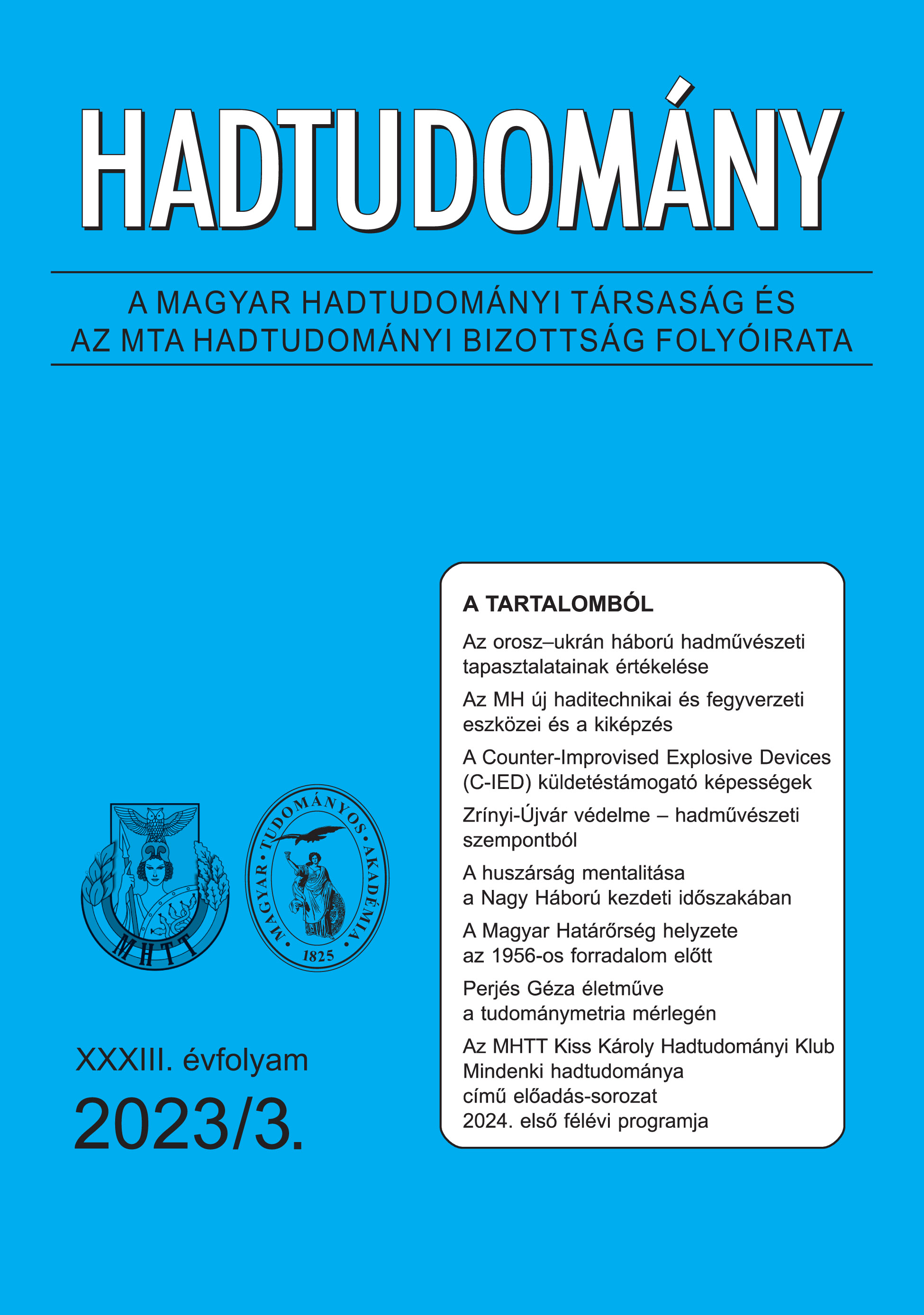Az Short Study: Describing the Major Features of the Russian Battalion Tactical Group Based on their Performance on the Battlefield
Absztrakt
A jelenleg is zajló orosz–ukrán háború előestéjén az orosz haderő legfontosabb szárazföldiszervezeti eleme a zászlóalj-harccsoport (battalion tactical group – BTG) volt. A háborútmegelőzően, 2021-ben a szerző már írt egy cikket, amelyben a BTG-k valós harcértékét vizsgálta.Ebben a cikkben a katonai szervezeteket összefoglalóan jellemző Warfighting Functions(WFF) alapján próbálta meg a BTG-k valós harcértékét megállapítani. Ebben az első cikkben aszerző arra a következtetésre jutott, hogy a BTG-k fő erőssége a tűzereje, a felderítő képességeés a gyors döntéshozatali rendszere, gyengesége pedig ennek a rendszernek a merevsége, valaminta logisztikája, illetve az erők megóvásának képessége. Ez alapján a szerző azt állította,hogy a BTG egy veszélyes, magas harcértékű szervezet, amennyiben sikerül a kezdeményezéstmegragadnia és a gyors döntéshozatali rendszerének, a katonák egyszerű, erősen specializáltkiképzésének köszönhetően az elsöprő tűzerejét a megfelelő sebességgel alkalmazni.A jelenleg is zajló háború első fél éve – eddig léteztek ugyanis szervezetszerű BTG-k –azonban ettől világosan eltérő képet mutat. Jelen publikációval a szerző célja az volt, hogyismét a WFF-ra támaszkodva megtalálja az orosz harcászati kudarcok okait. A szerzőnek aBTG-k valós képességeinek értékelésekor könnyebb dolga volt, mivel a háború csatáit, ütközeteitvizsgálva világosan levonhatók a következtetések, hogy az orosz BTG-k mely tulajdonságaivoltak előnyösek, melyek hátrányosak.A szerző a cikkben megállapította, hogy a gyors, de merev döntéshozatali rendszer teljesenkudarcot vallott. Ennek két fő oka van: az első a harcászati kezdeményezés gyorselvesztése a parancsnokok alacsony kezdeményezőkészsége miatt, a második pedig az elégtelenminőségű híradó rendszer. A BTG-k másik erőssége (tűzerő) pedig nem, vagy csak ritkántudott érvényesülni az előbb említett túlságosan merev döntéshozatali rendszer, valamint alassú és elégtelen kommunikációs rendszer miatt. Az orosz haderő legfontosabb szárazföldiszervezeti eleme nem tudott reagálni az ukrán haderő által az első napokban alkalmazott, korlátozottcélú támadásaira és halogató harcra épülő harceljárásaira. Később pedig a merev,parancsorientált döntéshozatali rendszer megfosztotta a kedvező terepre támaszkodó, létszámábannagyjából egyenlő ukrán védelem áttöréséhez szükséges logisztikai támogatástól ésharcászati rugalmasságtól.
Hivatkozások
Fiore, Nicholas J. Defeating the Russian Battalion Tactical Group, 2017. Online: www.benning.army.mil/armor/earmor/content/issues/2017/spring/2Fiore17.pdf
Grau, Lester W Dr, and Charles K Bartles 2016. The Russian Way of War. Fort Leavenworth: Foreign Military Studies Office, 2016.
Karber, Philip A. 2015. Lessons Learnt from the Russo–Ukraine War. The Potomac Foundation, 2015.
Kofman, Michael, and Lee, Rob. Not Built for Purpose: The Russian Military’s Ill-fated Force Desing. War on The Rocks https://warontherocks.com/2022/06/not-built-for-purpose-the-russian-militarys-ill-fated-force-design/ (Downloaded 03.06.2022.)
Masuhr, Niklas 2019. Lessons of the War in Ukraine for Western Military Strategy. CSS Analyses in Security Policy, no 242. (2019).
McDermott, Roger N and Charles K Bartles 2020. The Russian Military Decision-Making Process and Automated Command and Control. GIDSresearch, no 2 (2020).
McDermott, Roger N. 2017. Russia’s Electronic Warfare Capabilities to 2025. ICDS, September 2017. Online: https://icds.ee/wp-content/uploads/2018/ICDS_Report_Russias_Electronic_Warfare_to_2025.pdf
Scott, Boston, Scott and Dara Massicot, Dara 2017. The Russian Way of Warfare. RAND Corporation, 2017.
Szatmári Balázs 2022. Elektronikai hadviselés az orosz–ukrán háború tükrében. Hírvillám, NKE Híradó Tanszék.
Takács, Márk 2020. A kelet-ukrajnai szárazföldi hadműveleteinek bemutatása. MSc thesis, 2020.Budapest: NKE HHK.
Takács, Márk 2021. A short study – describing the major features of the Russian Battalion Tactical Group. AARMS, 20 (2): 49–67.
https://doi.org/10.32565/aarms.2021.2.5
Vershinin, Alex: The Return of Industrial Warfare https://www.rusi.org/explore-our-research/publications/commentary/return-industrial-warfare




